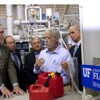Abstract
Ethanol can be derived from sugar-based, corn-based, and cellulose-based materials. Production of ethanol from sugar and corn is often viewed as competing with food production and increasing prices of food and fuel. But using non-edible cellulose-based biomass to produce ethanol minimizes competition with the food industry. This 4-page fact sheet provides a general overview of the production process for manufacturing ethanol from cellulosic biomass, including its constituents, conversion processes, and final products. Written by Zhaohui Tong, Pratap Pullammanappallil, and Arthur A. Teixeira, and published by the UF Department of Agricultural and Biological Engineering, November 2012.
AE493/AE493: How Ethanol Is Made from Cellulosic Biomass (ufl.edu)
References
Chandra, P. R., R. Bura, W.E. Mabee, A. Berlin, X. Pan, and J. N. Saddler. 2007. "Substrate Pretreatment: The Key to Effective Enzymatic Hydrolysis of Lignocellulosics?" Advances in Biochemical Engineering/Biotechnology 108:67-93. https://doi.org/10.1007/10_2007_064
Energy Bulletin. 2010. "Peak Oil and Suppliers." Accessed September 10, 2012. http://www.energybulletin.net/stories/2010-04-07/peak-oil-supplies-april-7.
Energy Information Administration (EIA). 2012. "How Much Ethanol Is in Gasoline and How Does It Affect Fuel Economy?" Accessed November 20, 2012. http://www.eia.gov/tools/faqs/faq.cfm?id=27&t=10.
Geddes, C.C., J.J. Peterson, C. Roslander, G. Zacchi, M.T. Mullinnix, K.T. Shanmugam, and L.O. Ingram. 2010. "Optimizing the Saccharification of Sugar Cane Bagasse Using Dilute Phosphoric Acid Followed by Fungal Cellulases." Bioresource Technology 101(6):1851-7. https://doi.org/10.1016/j.biortech.2009.09.070
Mosier, N., C. Wyman, B. Dale, R. Elander, Y.Y. Lee, M. Holtzapple, and M. Ladisch. 2005. "Features of Promising Technologies for Pretreatment of Lignocellulosic Biomass." Bioresource Technology 96 (6):673-86. https://doi.org/10.1016/j.biortech.2004.06.025
Olofsson, K., M. Bertilsson, and G. Lidén. 2008. "A Short Review on SSF - An Interesting Process Option for Ethanol Production from Lignocellulosic Feedstocks." Biotechnology for Biofuels 1:7. https://doi.org/10.1186/1754-6834-1-7
Ragauskas, A.J., C.K. Williams, B.H. Davison, G. Britovsek, J. Cairney, C.A. Eckert, W.J. Frederick, Jr., J.P. Hallett, D.J. Leak, C.L. Liotta, J.R. Mielenz, R. Murphy, R. Templer, and T. Tschaplinski. 2006. "The Path Forward for Biofuels and Biomaterials." Science 311:484-9. https://doi.org/10.1126/science.1114736
Rowell, R.M. 2005. Handbook of Wood Chemistry and Wood Composites. Boca Raton, FL: CRC Press. https://doi.org/10.1201/9780203492437
U.S. Department of Energy, Energy Efficiency and Renewable Energy (EERE) Biomass Program. 2012. "Feedstock Types." Accessed September 7, 2012. http://www1.eere.energy.gov/biomass/feedstocks_types.html.
U.S. Department of Energy, EERE Biomass Program. 2012. "Biofuel Initiative." Accessed September 10, 2012. http://www1.eere.energy.gov/biomass/biofuels_initiative.html.
Wyman, C.E. 2010. "Cellulosic Ethanol: A Unique Sustainable Liquid Transportation Fuel." Biomass & Biofuels 33:381-2. https://doi.org/10.1557/mrs2008.77

